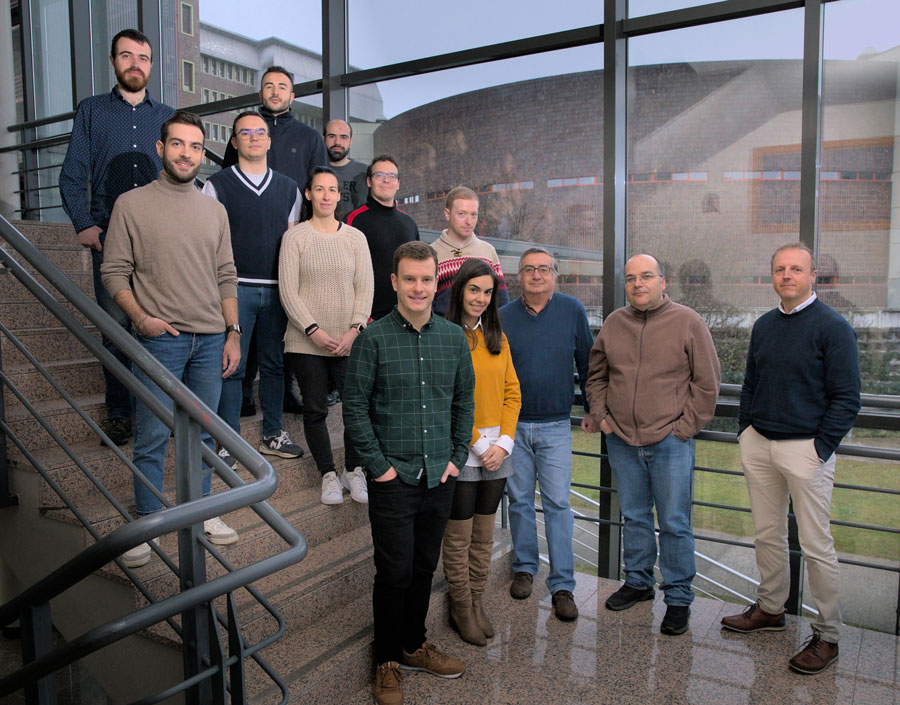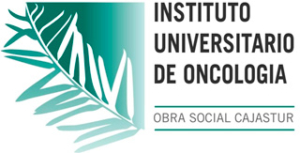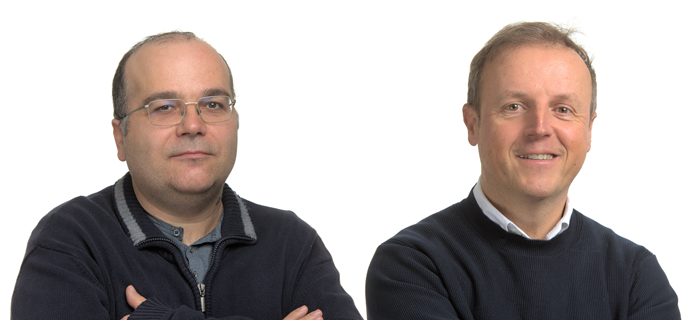UNIT HEADS
Felipe Lombó Brugos
Ángel Manteca Fernández
LOCATION
Dpto. de Biología Funcional. Área de Microbiología. Facultad de Medicina. Planta 2ª
RESEARCH LINES
Streptomyces is a very important industrial microorganism, as different species belonging to this genus produce two thirds of clinically relevant secondary metabolites (antibiotics, antitumorals, immunosupressors, etc.).
It is considered as a “multicellular” prokaryotic model that includes programmed cell death and sporulation in solid cultures. Streptomyces industrial fermentations are mainly produced in liquid cultures (large bioreactors), conditions in which most species do not sporulate, and it was traditionally considered that there was no differentiation.

Fig. 1. Streptomyces developmental cycle in solid (sporulating) and liquid (non-sporulating) cultures. New developmental stages described by A. Manteca’s group are highlighted in red. MI, first compartmentalized mycelium, vegetative; MII, second multinucleated mycelium, secondary metabolite-producing mycelium.
Our research group defined a new Streptomyces developmental cycle in solid and liquid cultures, identifying by first time, the antibiotic producer mycelium. Understanding the biochemical regulation of differentiation and activation of secondary metabolism is one of the keys for the optimization of hyphae differentiation in industrial fermentations.
Finding new secondary metabolites is becoming critical in biomedicine, and the only way to discover new compounds will be to resume screening from natural strains. The latest discoveries about Streptomyces differentiation are crucial to optimize the screening, reducing the incidence of false negatives.
We have developed different platforms for industrial production of bioactive metabolites in S. albus and S. coelicolor, as non-ribosomal peptides (the antitumor thiocoraline), sensor peptides for detection of specific cells, and diverse stilbenoids and flavonoids with antitumor and anti-inflammatory activities. These polyphenols are interesting for their use as nutraceuticals and cotherapy bioactive compounds, especially in breast and prostate carcinomas. In both tumors, these nutraceuticals are able to modulate the activity of the estrogen and androgen receptors, inhibiting the growth of these tumors.

Fig. 2. Production of biosensor peptides in Streptomyces: tridimensional structure of the fluorescent biosensor protein used for detection of E. coli in drinking water.
We also develop microalgae species as industrial producers of various types of bioactive compounds, mainly antibiotic (for their use as anti-biofilm agents) and antitumor compounds. The objective is to isolate novel bioactive compounds, to discover their biosynthetic pathways, and to generate derivatives with increased pharmacological properties.
Our group also develops strategies for prevention of colorectal cancer. In collaboration with several companies, we developed functional prebiotic meat products, which protect against colorectal carcinoma. These functional foods reduced by 57% the occurrence of colon tumors in an animal models. Results paved the way to further validate functional foods in the prevention of human colon carcinoma.

Fig. 3. Experiments with prebiotic functional foods using an animal model for colon cancer. Left: functional food animals show 50% reduction in number of colon tumors, with respect to feed and control food animal groups. Right: functional food animals show 65% reduction in tumor affected colon mucosa area, with respect to feed and control food groups.
GROUP HEADS BIOGRAPHIES
Felipe Lombó is Doctor in Biology from the University of Oviedo (1998) and Professor at this university since 2008. He has done his research activity mainly in the Ruhr-Universität Bochum (Germany), University of Oviedo and Stanford University (USA), with shorter stays in Georg-August Universität Göttingen (Germany), Analyticon AG (Germany), University of São Paulo (Brazil) and The University of Tokyo (Japan). He develops researches related to ultrafast methods of detection of pathogens. However, the main research line focuses on the development of new anti-tumors (bacterial or plant origin), antibiotics (to prevent infection by biofilms) and nutraceuticals (flavonoids, stilbenes, etc.) in bacterial (Streptomyces) and microalgae factories, improved by genetic engineering, and scalable (industrial production). Researches include digestive microbiota metagenomics studies, analysing changes associated with functional food intake and its relation to prevent colon carcinoma. He is author of 4 national patents and 3 world patents; two licensed to pharmaceutical and engineering companies.
Dr. A. Manteca obtained the Biology degree from the University of Oviedo in 2000 and a PhD-degree in Microbiology, in 2005. After a postdoctoral stay at the University of Southern Denmark, working in quantitative mass spectrometry, he returned to the University of Oviedo as a postdoctoral researcher in 2011. The same year, A. Manteca obtained an ERC Starting Grant (STRP-DIFFERENTIATION – 280304), and since January 2012, he is an Associate Professor in the University of Oviedo. The main research line of Dr. Manteca focus in the study of Streptomyces biology, differentiation, and biotechnological applications. Streptomyces is a Gram-positive bacterium characterized by a complex developmental cycle, which is the evolutionary origin of some of the eukaryotic signalling protein domains (apoptotic ATPases, kinases, caspases, nucleases, etc.). In addition, it is a very important industrial bacterium producing two thirds of clinically relevant secondary metabolites (antibiotics, antitumorals, etc.). A. Manteca’s research group was pioneer in the application of new experimental methods to the analysis of Streptomyces biology. At present A. Manteca’s group is applying all this knowledge to the search of new clinical drugs (antibiotics, antitumorals, etc.) from actinomycetes.
SELECTED PUBLICATIONS
- Gutiérrez-Del-Río I, Brugerolle de Fraissinette N, Castelo-Branco R, Oliveira F, Morais J, Redondo-Blanco S, Villar CJ, Iglesias MJ, Soengas R, Cepas V, Cubillos YL, Sampietro G, Rodolfi L, Lombó F, González SMS, López Ortiz F, Vasconcelos V, Reis MA. Chlorosphaerolactylates A-D: Natural Lactylates of Chlorinated Fatty Acids Isolated from the Cyanobacterium Sphaerospermopsis sp. LEGE 00249. J Nat Prod. 2020 Jun 26;83(6):1885-1890.
- González-Quiñónez N, Gutiérrez-Del-Río I, García-Cancela P, Fernández-García G, Alonso-Fernández S, Yagüe P, Pérez-Valero Á, Montes-Bayón M, Lombó F, Manteca Á. The Modulation of SCO2730/31 Copper Chaperone/Transporter Orthologue Expression Enhances Secondary Metabolism in Streptomycetes. Int J Mol Sci. 2021 22:10143. doi: 10.3390/ijms221810143.
- Fernández J, Ledesma E, Monte J, Millán E, Costa P, de la Fuente VG, García MTF, Martínez-Camblor P, Villar CJ, Lombó F. Traditional Processed Meat Products Re-designed Towards Inulin-rich Functional Foods Reduce Polyps in Two Colorectal Cancer Animal Models. Sci Rep. 2019 Oct 15;9(1):14783.
- Marín L, Gutiérrez-Del-Río I, Entrialgo-Cadierno R, Villar CJ, Lombó F. De novo biosynthesis of myricetin, kaempferol and quercetin in Streptomyces albus and Streptomyces coelicolor. PLoS One. 2018 Nov 15;13(11):e0207278.
- Rioseras B, Shliaha PV, Gorshkov V, Yagüe P, López-García MT, Gonzalez-Quiñonez N, Kovalchuk S, Rogowska-Wrzesinska A, Jensen ON, Manteca A. Quantitative Proteome and Phosphoproteome Analyses of Streptomyces coelicolor Reveal Proteins and Phosphoproteins Modulating Differentiation and Secondary Metabolism. Mol Cell Proteomics. 2018 17:1591-1611. doi: 10.1074/mcp.RA117.000515.
- Yagüe P, Willemse J, Koning RI, Rioseras B, López-García MT, Gonzalez-Quiñonez N, Lopez-Iglesias C, Shliaha PV, Rogowska-Wrzesinska A, Koster AJ, Jensen ON, van Wezel GP, Manteca Á. (2016) Subcompartmentalization by cross-membranes during early growth of Streptomyces Nat Commun. 7:12467.

Personnel
| Name | Possition | Phone | |
| Ángel Manteca Fernández | PI | mantecaangel@uniovi.es | 985103555 |
| Felipe Lombó Brugos | PI | lombofelipe@uniovi.es | 985103593 |
| Claudio Jesús Villar Granja | Associate Prof. | cjvg@uniovi.es | 985102732 |
| Elisa María Miguélez González | Associate Prof. | emmiguelez@uniovi.es | 985102792 |
| Suhui Ye Huang | Postdoct | yesuhui@uniovi.es | Ext 5290 |
| Javier Fernández Fernández | Postdoct | UO186966@uniovi.es | Ext 5290 |
| Gemma Fernández García | PhD Student | gemmafg06@hotmail.com | Ext 5289 |
| Sergio Alonso Fernández | PhD Student | sergioalonsofernandez@gmail.com | Ext 5289 |
| Ignacio Gutiérrez del Río Menéndez | PhD Student | nachogutiem@gmail.com | Ext 5290 |
| Patricia Magadán Corpas | PhD Student | patricia.macor@gmail.com | Ext 5283 |
| Álvaro Pérez Valero | PhD Student | apv.moratalla@gmail.com | Ext 5283 |
| Luis Fernández Calleja | PhD Student | luiscalleja2010@hotmail.com | Ext 5283 |


